WEBORGERS-
The Belgian Comics (4)
SPIROU
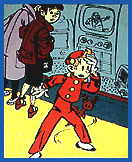
Spirou the ex hotel groom (by Franquin)
SPIROU: THE CHARACTER AND THE MAGAZINE...
In 1938, Jean Dupuis a visionary publisher active in the Charleroi region (southern part of Belgium), decided to create a comics magazine strictly orientated to the youngsters. The 'Journal de Spirou' - Spirou Magazine, was launched in 1938 and featured a central character that gave his name to the publication: Spirou...
Spirou by Robvel in the first issue of Spirou Magazine [1938]-hereunder
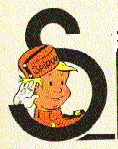
The first artist giving life to this character was Robvel who underlined very well the humor and vivacity of the young hotel groom Spirou. Propelled in gags and globe-trotter style of adventures as in favor in the 30's it supported very well the growth of the new magazine.
Very soon, Spip the squirrel was adopted by Spirou and became a character of the series that followed. However Robvel could not continue his collaboration as the Germans invaded Belgium in May 1940 and triggered the terrible WW2 in Western Europe. After some intermittent collaboration of other artists, end 1940 a young and talented Belgian artist overtake the Spirou Adventures: Jijé (Joseph Gilain). Having already some experience in publishing comics he will quickly put the Spirou series on wider grounds.
JIJÉ - THE EVOLUTION OF SPIROU...
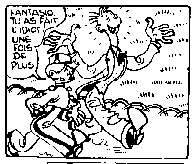 Under the powerful control of Jijé Spirou evolute quickly in graphic style and type of stories. More fantasy was injected in attractive and funny scenarios, the images gained in clarity.
Under the powerful control of Jijé Spirou evolute quickly in graphic style and type of stories. More fantasy was injected in attractive and funny scenarios, the images gained in clarity.
Under the advice of one of the Redactors, Jijé added a secondary character: Fantasio - [see this character in the image at right], that he deliberately pushed to caricature. Fantasio was not a dreamer as the Redaction wanted him to be, he was a pure fantasist instilling non-sense and catastrophes in the stories. A lot of hilarious situations were very well exploited by Jijé in many pages of gags centered on Fantasio.
Joseph Gilain, born in the Namur region in 1914, was one of the most talented artist of the Belgian comics and is the base of the modernization of the character of Spirou. He was also the hugely creative artist that by gathering new young talents around him after WW2 was at the origin of the style and later so-called 'school of Marcinelle' (Marcinelle= small town near Charleroi, location of the Editions Dupuis, publisher of Spirou).
Check for more details about Jijé in the additional page: JIJÉ -THE FATHER OF THE MODERN SPIROU...

FRANQUIN - IMAGINATION, POETRY, CREATIVITY.
SPIROU RECEIVES A WORLD FOR HIMSELF...
Due to excess of work by many series published at the same time, mid 1946 Jijé asked to André Franquin to take over the Spirou series. Franquin did it from the middle of a unfinished page by Jijé!
He will continue for the next 22 years...
Franquin became during these years one of the best comics artist of Europe, having an unchallenged genius for caricature and movement in the drawings. But he is more than just the sum of his technical abilities in drawings. Much more!!
The Spirou series bloomed under his creativity, becoming a mix of captivating stories, outrageous gags and devastating humor, allied to a view of a world where real friendship, courage and honesty are the prevalent values. But there were no moral propaganda in the Franquin pages of the Spirou series, just illustrations of how it should work with the help of Spirou and Fantasio.
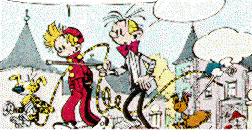 From one of the episodes in 1951, Franquin added a scientist specialized in improbable technologies,the Count of Chamignac, living in a castle in his small village of Champignac. This was the start of the creation of a typical world for the Spirou stories.
From one of the episodes in 1951, Franquin added a scientist specialized in improbable technologies,the Count of Chamignac, living in a castle in his small village of Champignac. This was the start of the creation of a typical world for the Spirou stories.
Marsupilami, Spirou, Fantasio and Spip in Champignac >>
Later he will make that Spirou and Fantasio travel more, using the help of talented scenarists as Greg and Delporte. But Franquin will always remain himself: gags and precise details of hilarious sequences will always be present.
In 1952 appears in the story: 'Spirou et les Héritiers' (Spirou and the heirs)a fantastic character,
the MARSUPILAMI- see our page for this character. It's probably the richest invention of Franquin and surely one of the cutest animal character of the Comics World! A legend!
Another character Franquin designed in 1957: GASTON - see our page for this character- appeared also from time to time with Spirou in short comics stories or in cartoons for the magazine.
Besides these prominent creations, Franquin sketches unforgettable secondary characters as well: gorillas, chimpanzees, Zorglub the megalomaniac dictator, the Maire of Champignac and his hollow phrases of political speeches, babies of the Marsupilami... the list is long and very funny!
 Franquin was never an advocate of violence in his comics and his values for peace and fraternity appeared in many stories of Spirou. There is also an aura of real poetry in the world he graphically described, without false decorum or self infatuation.
Franquin was never an advocate of violence in his comics and his values for peace and fraternity appeared in many stories of Spirou. There is also an aura of real poetry in the world he graphically described, without false decorum or self infatuation.
Spip the squirrel
The Spirou series had the incredible chance to be masterfully served by Franquin the best of Belgian comics artists of the second half of our century. The 20 albums he issued in the Spirou series until 1968 are amongst the best of the Belgian comics
NEW ARTISTS: FOURNIER, BROCA, TOME AND JANRY
In 1968, after having troubles to finish the two last albums of the Spirou series, Franquin stops his collaboration to it.
He was looking for shorter stories, more liberty in the subjects. Gaston was one of the possibility for him to aim these goals. He also continued to be very active in the illustration of announcements and short gags for the Spirou Magazine.
The Spirou series was then passed to Jean-Claude Fournier, young French artist that was partially trained by Franquin. It was a good choice as Fournier was keeping some poetry of himself in the stories and a taste for marvelous tales. Fournier produced the next 10 albums until 1979.
When he wanted to stop, the Publisher owing the rights of the character Spirou wanted to create a 'task team' with several artists to collaborate to the stories. This idea could never be totally implanted successfully and there was a few years were 5 to 6 artists were producing comics with the character of Spirou.
There was even a short production of old-fashion style of strips by a young artist: Yves Chaland. Chaland was mimicking early franquin style of the 40's and 50's.
After 3 albums by Broca, it was finally Tome and Janry a team of two young Belgian that were selected in 1983 to continue the series. They handled scenarios and drawings. They produced more than ten new albums for the Spirou series.
TOME AND JANRY: the future of Spirou is in his past!
In the Spirou series, Tome and Janry let appear their very good sense of humor with a zest of acidity. They evidently had a great sense of theater development techniques as well, very fit for developing short humor stories.
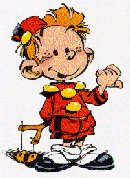 This special humor became very quickly of high interest to the readers when the two creators produced a parody of an imaginary childhood of Spirou: THE YOUNG SPIROU.
This special humor became very quickly of high interest to the readers when the two creators produced a parody of an imaginary childhood of Spirou: THE YOUNG SPIROU.
Iconoclastic, but respectful for the character, the new comics series is now growing. Young Spirou (or: Lill' Spirou) evolves in typical 1950's set-ups and his life is centered around his school and his family. Young Spirou and his friends are a bunch of witty, candid and turbulent young children creating highly amusing and funny situations. Discovery: Spirou was a little boy like the others and not a kind of icon! Very funny series of short stories developed in 2 to 6 pages of comics.
The series around Young Spirou is still going on in the Spirou weekly Magazine that celebrated his 3000th issue in October 95!!!
Spirou Magazine is most probably the Comics Magazine with the longest life in the history of the media.!!!
INTERESTING SPIROU LINKS
- Spirou and Fantasio -Interesting site in English that gathers a lot of info otherwise scattered on the WEB. Bio of Franquin, list of the Spirou albums and more. All assembled in one page only, so downloading can be slow.
To more comics! >>>>
![[To Front Page]](../go_to.gif)
To Front Page
E.Borgers
freeweb@rocketmail.com
Copyright© 1996 E.Borgers for text and set-up(see complete disclaimer in front page)
Most recent revision: 27 December, 1996



 Under the powerful control of Jijé Spirou evolute quickly in graphic style and type of stories. More fantasy was injected in attractive and funny scenarios, the images gained in clarity.
Under the powerful control of Jijé Spirou evolute quickly in graphic style and type of stories. More fantasy was injected in attractive and funny scenarios, the images gained in clarity.
 From one of the episodes in 1951, Franquin added a scientist specialized in improbable technologies,the Count of Chamignac, living in a castle in his small village of Champignac. This was the start of the creation of a typical world for the Spirou stories.
From one of the episodes in 1951, Franquin added a scientist specialized in improbable technologies,the Count of Chamignac, living in a castle in his small village of Champignac. This was the start of the creation of a typical world for the Spirou stories. Franquin was never an advocate of violence in his comics and his values for peace and fraternity appeared in many stories of Spirou. There is also an aura of real poetry in the world he graphically described, without false decorum or self infatuation.
Franquin was never an advocate of violence in his comics and his values for peace and fraternity appeared in many stories of Spirou. There is also an aura of real poetry in the world he graphically described, without false decorum or self infatuation.
 This special humor became very quickly of high interest to the readers when the two creators produced a parody of an imaginary childhood of Spirou: THE YOUNG SPIROU.
This special humor became very quickly of high interest to the readers when the two creators produced a parody of an imaginary childhood of Spirou: THE YOUNG SPIROU.